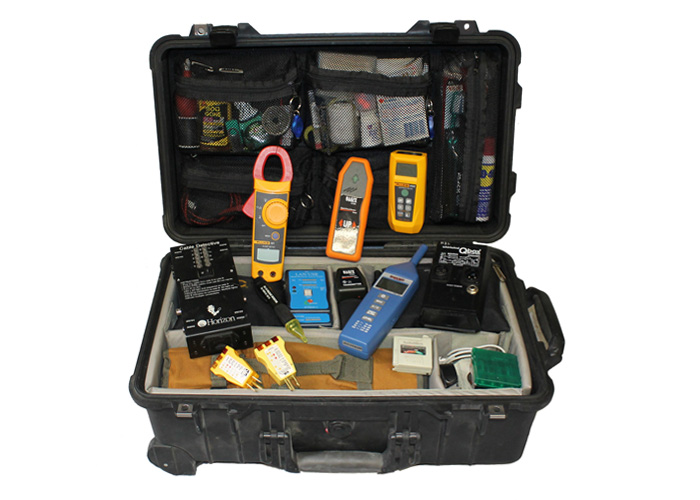Previously I detailed a checklist of “everyday carry” (EDC) tools that stagehands should always have on hand at every gig (see it here). It met with such a positive response that I’m going to share additional tools that invariable make me more efficient, and the job a bit easier.
While this might seem like a lot to lug around, I’ve found these items to be well worth the added weight and hassle.
To simplify transportation, I break them up into separate cases. A Pelican 1510 case holds meters and tools. (This has to be checked if I’m flying to a gig.) A standard hard-shell suitcase has been adapted as a carry-on, holding computers, iPad, utility mixer, headphones, and other items.
Q Box – If I can only have one extra tool in addition to my EDC, this is it. The Whirlwind Q Box line tester is my favorite tool, used for verifying that a signal is present and also serving as a signal generator.
Utility mixer – A Mackie 1202 serves this role, and can be used as a sub-mixer for additional inputs, as well as to provide additional output feeds with metering and as a back-up to the main console in case of failure on smaller gigs.
Computers – I usually carry two laptops for measurement, recording, editing and playback. For show cues, I use Sports Sounds Pro software instead of carrying my 360 Systems Instant Replay. Focusrite 8i6 interfaces handle inputs and outputs.
Pads & pods – In addition to an iPhone, I carry an iPad and iPod Touch loaded with console remotes (both audio and lighting) and other helpful apps. An Apple Airport Express provides a network when needed.
Cans & coms – Everybody likes to use their own headphones (a.k.a., “cans”) and intercom headsets, and I’m no exception. My headgear includes Koss cans, R-Columbia lightweight intercom headset, and Eartec wireless comm system.
Mics, clips & screens – My travel kit includes a Shure SM58, Shure SM57, Shure MX418 with base, Countryman B2D lavalier and Dayton Audio Measurement mic. A few mic clips and assortment of windscreens are tucked in for good measure.
SPL meter – The Galaxy CM-130 meter that I use provides more accurate readings than the apps built into my Apple devices.
Multi-meter – My choice is a Fluke 321 volt meter. The clamp allows me to measure the current draw (amperage) on the feeder legs on a PD without interrupting power.















